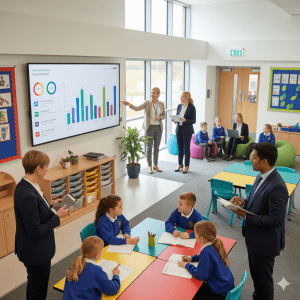Summary
The Ofsted Inspection Framework is the statutory set of guidelines used by Ofsted—the Office for Standards in Education, Children’s Services and Skills—to inspect, regulate, and report on schools and educational services in England.
It defines the criteria and processes that inspectors use to judge the quality of education, leadership, safeguarding, and personal development in all state-funded schools, academies, and registered childcare providers (Source: Ofsted – Education inspection framework).
If you want to understand how Ofsted ratings actually work for schools, teachers, and parents, check out our complete guide to Ofsted ratings.
Ofsted Inspection Framework Meaning and Purpose
Ofsted’s core purpose is to ensure all children and young people in England have access to a high standard of education and care. The Inspection Framework provides a consistent, transparent structure for evaluating how well educational institutions are serving their students and communities. 
It sets out four key areas for inspection:
- Quality of Education
- Behaviour and Attitudes
- Personal Development
- Leadership and Management
Inspectors make judgments based on these areas and publish reports that inform parents, staff, and government about the effectiveness of each school.
How the Ofsted Inspection Framework Works
Ofsted inspections are typically announced with only a short notice period (usually two days). Inspectors visit the school, observe teaching, review lesson plans, and speak with staff and students. They gather evidence on curriculum quality, student welfare, leadership, and overall effectiveness.
As of September 2024, Ofsted has stopped issuing overall single-word judgments like “Outstanding,” “Good,” “Requires Improvement,” or “Inadequate.” Instead, schools receive a detailed “report card” describing their strengths and weaknesses in each area. The new system aims to give parents and communities clearer, more actionable information (Source: Education Hub – Removal of Ofsted Single-word Judgements).
Schools previously rated as good or outstanding are still inspected less frequently than those needing improvement, but all now receive regular in-depth reviews (Source: Ofsted Inspections Explained).
Ofsted Inspection Framework – Evolution and Key Changes
1992: Ofsted established to bring rigour and independence to school inspection.
2001–2007: Expanded remit to childcare and adult learning providers (Source: Journal of Early Childhood Research).
2013: Shortened inspection notice periods for more authentic snapshots of school life.
2015: The Common Inspection Framework unified expectations for all providers.
2019: Launch of the Education Inspection Framework (EIF), focusing on curriculum “intent, implementation, and impact” (“the three I’s”) and separating behaviour from personal development (Source: EIF Launch).
2024: The single-word overall grades were scrapped in favour of a multi-part “report card” system, rolling out fully by September 2025.
Ofsted Inspection Framework – Current Stats and Insights
- Scale: Ofsted inspects over 20,000 state-funded schools and more than 15,000 childcare providers in England (Source: Ofsted Annual Report 2022/23).
- Recent Outcomes: As of December 2023, 90% of state schools were rated “Good” or “Outstanding,” up from 68% in 2010 (Source: UK Parliament).
- Primary vs. Secondary: 91% of primary schools were rated Good/Outstanding, compared to 83% of secondaries (Source: Ofsted).
- Safeguarding: Since 2022, the number of schools judged to have ineffective safeguarding has more than doubled, rising from 59 to 135 schools in 2024. The main reasons cited for ineffective safeguarding include poor record keeping (53%), weak leadership and governance (45%), and failure to follow up concerns properly (44%). (Source: Judicium Education)
Ofsted Inspection Framework – Professional and Regulatory Insights
- The 2019 EIF is praised for moving inspection away from narrow test data and towards a richer, broader view of what children actually learn and experience at school (Source: Education Policy Institute).
- Regulatory reviews note that the focus on curriculum has improved discussions around teaching and leadership, but some school leaders report significant inspection-related stress and a need for more nuanced judgments, especially in challenging circumstances (Source: Journal of Education Policy).
- Ofsted itself has acknowledged workload concerns and, from September 2024, is piloting changes to reduce stress—such as no longer giving a single overall grade, instead breaking judgments into clearer categories.
Disclaimer: All the information provided was correct at the time of publication (August 2025) and was collected with the help of accredited tools and AI.
Author Profile
- Publishing the latest education, EdTech and career news.
Latest entries